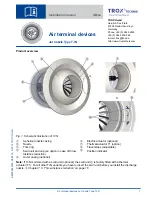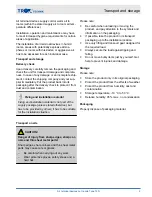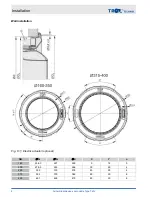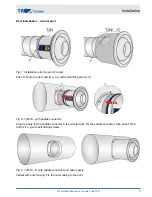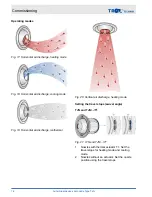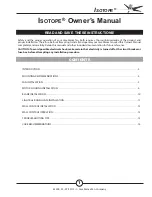
S1
Direction of rotation
Pos. 0
Actuator has stopped (undefined position)
Pos. 2
Cooling
Pos. 3
Heating
Modulating actuators
Fig. 16: Variable control
①
Setpoint adjuster: Y = voltage signal
2-10 V DC
②
Modulating actuator
(0) 2 V - Travel stop – cooling
10 V
- Travel stop – heating
Commissioning
Initial commissioning
Before you start commissioning:
Check that the jet nozzles are correctly seated.
Remove protective film, if any.
Ensure that all jet nozzles are clean and free
from residues and foreign matter.
Check that electrical connections (if any) have
been correctly made.
Ensure that the devices have been correctly
fixed and connected to the ducting.
For jet nozzles with electric actuator: Check
that the position of each discharge nozzle
matches the operating mode,
Ä
Chapter
7.3 ‘Operating modes ’ on page 14
Note:
If the position of the discharge nozzle is not
as it should be, you can change the direction of
rotation on the actuator by swapping the terminal
connections.
For commissioning see also VDI 6022, part 1 – 'Hy-
giene requirements for ventilation and air-condi-
tioning systems and units'.
Thermal actuator T1
The smallest and largest swivel angles are reached
with supply air temperatures of ≤ 18 °C and
≥ 30 °C.
Be sure to position the jet nozzle correctly for instal-
lation,
Ä
5.1 ‘Installation orientation’ on page 6
. An
incorrect position may impair its function.
A 'standard' jet nozzle cannot be retrofitted with a
thermal actuator unit at a later stage since a
thermal actuator requires a casing that is 60 mm
longer.
Jet nozzles with thermal actuator may be factory
fitted with a swirl unit (option) but it is not possible
to retrofit a swirl unit at a later stage.
Removing the factory mounted swirl unit may impair
the function of the jet nozzle.
Commissioning
Air terminal devices Jet nozzle Type TJN
13

